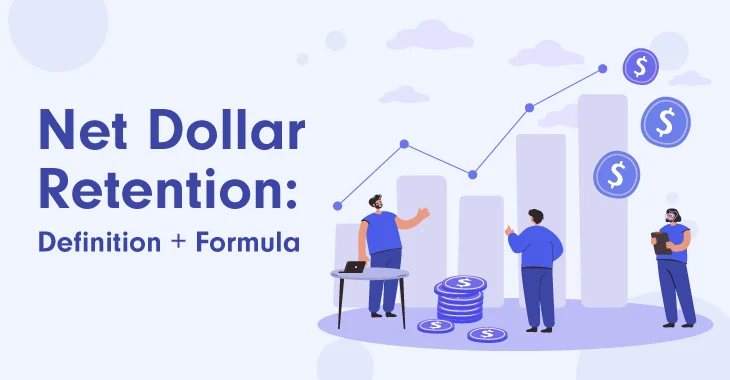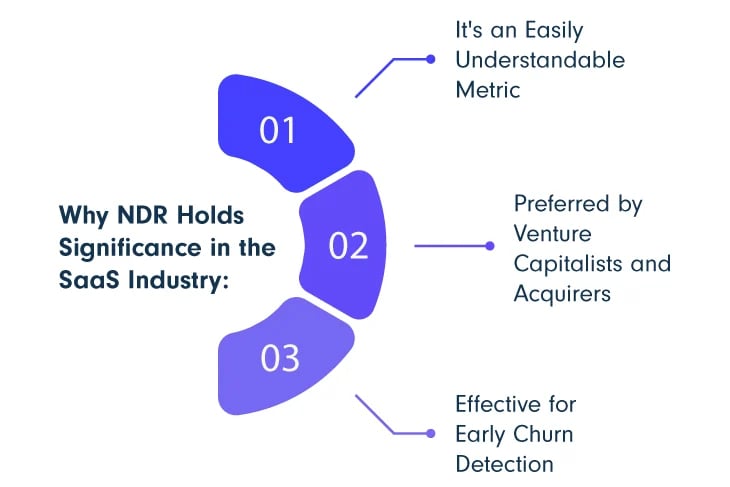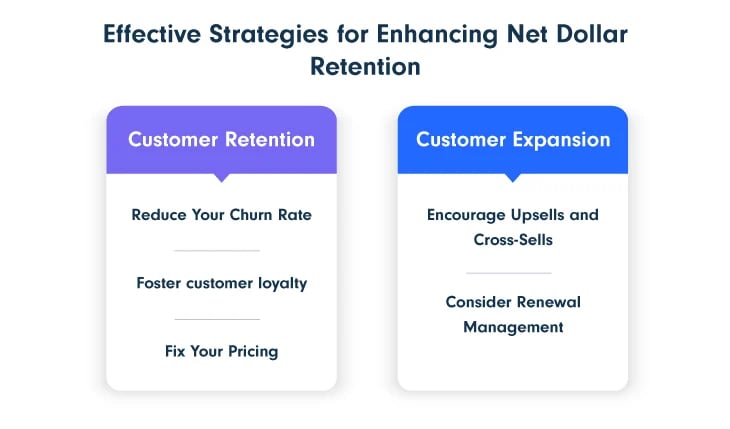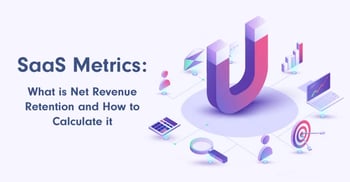Net Dollar Retention: Definition + Formula

Think of the competitive SaaS industry as a garden. First, you need to plant the seeds (acquire the customers) and nurture them ( through onboarding and marketing tactics) in the hopes they turn into strong plants (loyal customers).
Then, to maintain a thriving ecosystem (retention of existing customers) that yields bounty, you need to keep an eye on your plants (gain insight using important metrics) and ensure daily care (stellar support and constant updates to reduce churn).
Only a well-managed SaaS business will lead to steady, long-term recurring revenue.
To keep this metaphor simple: Your shovel to a thriving SaaS garden is Net Dollar Retention (NDR), an essential metric that focuses on efficient growth.
So, let’s dig in: (see what we did there?)
What Is Net Dollar Retention?
Regarded as a highly important metric, Net Dollar Retention (NDR) offers insights into how a company’s ARR (annual recurring revenue) has changed within a particular period.
To gain a more time-specific revenue perspective, SaaS businesses can also use the MRR (monthly recurring revenue) instead of its ARR.
Because it is a key performance metric, net dollar retention looks at how successful a SaaS company is at winning, keeping, and upgrading users. So, the higher the net revenue retention is, the better.
How To Calculate Net Dollar Retention (NDR)
The math behind calculating the net dollar retention rate is:
NDR = (Starting ARR + Expansion - Downgrades-Churn) / Starting ARR
For a more up-to-minute snapshot of your SaaS’s performance, you need to adapt the NDR formula integrating MRR information like so:
NDR = (Starting MRR + Expansion MRR - Downgrades MRR - Churn MRR) / Starting MRR
Let’s dive into an example to make the NDR calculation using ARR data clearer:
Company X starts the year with an ARR of $ 1,000,000.
During that year, a considerably large number of its current customers decided to increase their usage of the SaaS app, bringing an expansion revenue of $ 200,000.
On the other hand, some of their existing customers decided to switch to a basic plan from a premium one, leading to losses of $50,000. Additionally, others ended their subscriptions, so Company X lost $20,000 in revenue churn.
NDR= (1.000.000 + 200.000 -50.000 - 20,000)÷1.000.000*100 = 113%
Applying the data to the above-mentioned formula, the NDR rate would add up to 113%.

Looks good, right? But is it? Let’s find out!
Net Dollar Retention Benchmark
It is generally considered a good NDR if it goes over 100%, as this would imply that there is an increase in revenue from your current customers.
In other words, your SaaS business can continue its expansion without having to gain any new subscribers.
Just look at these rapidly scaling SaaS businesses:
Snowflake: 151%
DataDog: 130%
Confluent: 130%
SentinelOne: 128%
Therefore, anything under 100% is regarded as a low NDR rate, also known as a leaky bucket. This means that your business is heavily spending on gaining users but letting them slip away afterward.
According to 2023 market data, the approximate median is 115%.
Now, to answer the previous question, Company X, with an NDR of 113%, while it’s on the right track, needs to double down on customer retention efforts.
Why Does NDR Matter To SaaS?
Businesses with a high NDR grow fast. It’s that simple.
Keeping track of this rate means monitoring customer retention and engagement, which are two of the most lucrative areas within the SaaS business model.
Net Dollar Retention is one of the most important metrics because it tells you:
How much your SaaS can grow without acquiring new revenue streams
How sticky your product is
Also, here are three more reasons why you need to shortlist this KPI.

1. It’s a Simple and Straightforward Metric
Net dollar retention is widely favored because of its power to easily harness and deliver essential data-driven insights.
However, this performance KPI gives you a quick snapshot of how healthy your SaaS business is.
For a more detailed understanding and depending on your NDR findings, you might still want to track other relevant metrics like customer lifetime value (LTV) or your churn rate. A quick look into CRM data could be useful, as well.
2. It’s the VC or Aquirer’s Favorite Pick
Every potential investor or acquirer perceives NDR as a cornerstone metric. Why? Because it provides the big picture of a company’s allure.
An investor typically isn’t satisfied with seeing only the current total revenue. They usually are more interested in a business’s growth opportunities.
Can it retain customers? Is the customer experience with the product satisfying enough to generate additional revenue?
Fortunately, the NDR rate answers these key questions.
3. It’s Great for Detecting Churn Early On
The SaaS industry is as alluring as it is challenging. So much so that you might think you are winning even when you are unknowingly losing.
This is what happens when SaaS companies have a higher revenue generated from newly acquired customers than the lost revenue from their existing customer base.
NDR helps you identify these holes, which would otherwise go unnoticed and continue eating into your profit.
Gross Dollar Retention Vs. Net Dollar Retention
While both metrics are used to gain insight into the profitability and growth of your SaaS business, they are different in how they measure data.
Now that we know what NDR is, let’s take a look at gross revenue retention.
What is Gross Retention?
Gross Dollar Retention (GDR) is a key KPI metric used to measure the total revenue retained from existing customers without taking into consideration additional revenue generated.
Like Net Dollar Retention, GDR is also affected by both customer churn and downgrades. But if NDR takes into account expansion revenue, gross retention also considers subscription reactivations.
GDR Formula
The formula used to calculate gross retention is:
GDR = (Beginning MRR - Downgrades - Churn) / Beginning MRR
GDR Benchmark
Unlike NDR, Gross Dollar Retention provides a more conservative assessment of a SaaS developer's business health, as it solely accounts for revenue derived from existing customers.
Net Dollar Retention considers expansion revenue as well, making it a more growth-oriented metric.
This is why the average GDR rate cannot go over 100%, and the NDR rate is supposed to.
Within the SaaS industry, the median gross retention rate is 91%.
5 Best Practices To Improve Net Dollar Retention
NDR is undeniably a business-centric metric, and the strategies for achieving success can vary depending on the nature of your company. In general, though, there are two main approaches to boost the net dollar retention rate.

Customer Retention
The first thing you need to make sure is that you are narrowing the gap when it comes to losing customers. Your revenue retention rate is a key NDR component to customer attrition.
Reduce Your Churn Rate
While optimizing NDR is the focus, you also need to carefully consider your SaaS spending. And the truth is that reducing your churn is far less expensive than acquiring new ones.
Here are a few ways you can do that:
Constantly monitor SaaS metrics: Leveraging CRM data points is very important as it gives a clue of the areas you need to improve. You need to first understand why users are canceling your subscriptions before you can do anything about it.
Offer excellent customer service: Dealing with user issues promptly and professionally is crucial when trying to lower SaaS churn. Answer user queries as quickly as possible, offer rapid assistance for everything, and make product changes based on customer feedback.
Improve your onboarding process: Heyday managed to decrease its churn rate from 8.5% to 3.3% simply by streamlining their onboarding flow. A strong first interaction that rapidly delivers value to users will keep users happily hooked and boost app stickiness.
Foster Customer Loyalty
In a highly competitive industry like the SaaS market, achieving sustained business growth is only possible by building customer loyalty.
Here's how:
Use Net Promoter Score: NPS measures customer loyalty, looking at how likely users are to recommend your products or services to friends or business partners. SaaS businesses with a high NPS score also have lower churn and increased customer retention rates.
Implement loyalty programs: Show your appreciation for customers who stick by your brand by offering them exclusive benefits such as discounted rates on premium features, early access to product updates, or special discounts.
Offer a variety of payment options: Lower payment failures and cart abandonment through a smart mix of payment methods and currencies, considering the markets in which you are selling. Make it easy for your users to pay.
Fix Your Pricing
The easiest way to get your product noticed in a competitive market like the SaaS industry is by setting an affordable price. But that might mean sacrificing short-term profitability.
At one point or another, to upscale your business, you will need to increase your prices.
Make sure you align your SaaS prices not only with your profitability goals but with your customer segments, their needs, and possible budgets. Careful product monetization can lead to long and thriving customer relationships, help achieve revenue growth, and significantly reduce churn.
Customer Expansion
After working on reducing subscription cancellations, you need to move on to customer expansion. By this, we mean increasing your monthly recurring revenue from your existing users and not boosting customer acquisition by gaining new subscriptions.
Here are a few techniques to help you achieve your revenue expansion goals:
Encourage Upsells and Cross Sells
The easiest way to increase expansion revenue is to convince existing users to switch to higher-tier plans or packages to receive additional value.
Also, offering complementary products, add-ons, or services to enhance current subscriptions is an effective strategy for enhancing recurring revenue.
Through optimized checkout pages and providing users with their preferred payment methods and currencies, you can increase revenue.
Consider Renewal Management
You’ve managed to win new customers and even kept them active and loyal throughout their paid subscriptions. Now, you need to figure out a way to convince them to continue using your solution.
That’s when your top-notch revenue team enters the stage.
By closely and regularly monitoring your customer base, building strong relationships, achieving customer satisfaction, and offering early renewal offers, your business will reach long-term success.
How Can PayPro Global Help?
Improving subscription revenue can be considerably streamlined when you have a dedicated partner working with you to make consistent improvements for your shoppers.
PayPro Global’s unified solution gives you all the tools you need to test, implement, and monitor SaaS growth strategies, eliminating the need for third-party integrations and taking the pressure off of you to keep up with feature requests.
Our payment infrastructure offers you the right mix of methods and currencies, allowing you to gain your subscribers’ trust by responding to global payment preferences. Through hassle-free, mobile-friendly, and branded checkout pages, your users will be able to quickly and effortlessly pay for your product.
With the help of PayPro Global’s subscription engine, you can lower your churn rate through automatic subscriptions, as well as customize your charges, including upgrading or on-demand transactions, fostering revenue generation, and operational optimizations.
Through AI-driven SaaS analytics and BI tools, our solution ensures constant revenue monitoring and delivers intelligence that can assist you in making the right business calls.
Visit PayPro Global or reach out to find out how we can help you stay on top of your SaaS pricing strategy.
Final Thoughts
Oftentimes, a SaaS business can be very much like a bucket filled with holes. Why struggle to constantly refill it if you don’t plan on fixing the holes?
Net Dollar Retention is an important metric not just because it tracks your SaaS’s growth opportunities but because it sheds light on your blind spots and revenue holes.
So, yes, monitoring your customer retention rate and constantly working on achieving customer success can be a lot of work, but it’s well worth it.
Because when you do, you are gaining sustainable growth, not just short-term profits.
FAQ
What Is Net Dollar Retention?
Net Dollar Retention (NDR) offers insights into how well a SaaS business handles customer retention and revenue expansion. To offer relevant data for a specific period, this metric considers Annual Recurring Revenue (ARR) or Monthly Recurring Revenue (MRR).
How To Calculate Net Dollar Retention (NDR)?
To calculate NDR, you can use the following formula:
NDR = (Starting ARR + Expansion - Downgrades - Churn) / Starting ARR * 100.
You can also calculate it by using MRR data, and to do so, you need to replace ARR with MRR.
What Is a Good Net Dollar Retention Benchmark?
When the NDR is above 100%, it means that the SaaS business in question can obtain revenue growth without acquiring new users. The benchmark for NDR is 115%. However, anything below 100% signals a need to improve customer retention efforts.
Why Does Net Dollar Retention Matter To SaaS Businesses?
There are certain reasons why SaaS businesses keep NDR so close to their heart:
- Shows how much revenue growth can be obtained without acquiring new users.
- Measures product stickiness and customer loyalty.
- Allows investors to better understand a business’s growth potential.
- Helps prevent and decrease churn.
What Is the Difference Between Gross Dollar Retention and Net Dollar Retention?
Gross Dollar Retention (GDR) is a more straightforward metric, focusing solely on the revenue gained for existing customers. Expansion revenue is not considered. NDR, on the other hand, takes into account additional revenue sources, thus being able to provide insights into a company’s growth potential.
Ioana Grigorescu
Ioana Grigorescu is PayPro Global's Content Manager, focused on creating strategic writing pieces for SaaS, B2B, and technology companies. With a background that combines Languages and Translation Studies with Political Sciences, she's skilled in analyzing, creating, and communicating impactful content. She excels at developing content strategies, producing diverse marketing materials, and ensuring content effectiveness. Beyond her work, she enjoys exploring design with Figma.
-
1.Explore PayPro Global's Solutions: See how our platform can help you streamline your payment processing and boost revenue.
-
2.Get a Free Consultation: Discuss your specific needs with our experts and discover how we can tailor a solution for you.
-
3.Download our Free Resources: Access valuable guides, checklists, and templates to optimize your online sales.
-
4.Become a Partner: Expand your business by offering PayPro Global's solutions to your clients.
Get the latest news



